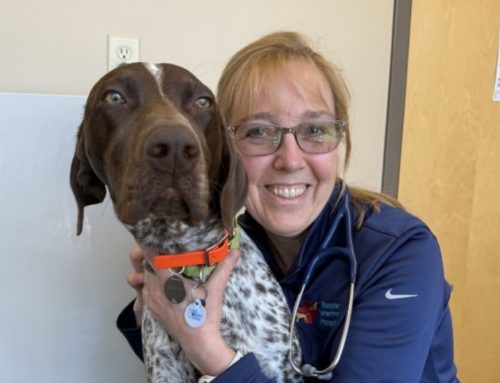As a devoted pet owner, you want to ensure your beloved companion has a long, healthy, happy life by your side, although you wish providing top quality care cost a little less. Fortunately—for your wallet and your furry pal—responsible pet ownership can actually reduce overall health care costs through regular wellness and preventive care. Learn how you can keep your best friend healthy, and your wallet happy, by investing in your pet’s wellness care.
#1: Invest in routine wellness care to catch problems early in your pet
Wellness care for pets is much more than vaccines. With each wellness visit at Bassler Veterinary Hospital, Dr. Bassler carefully checks your pet from nose to tail, inside and out, to search for any abnormalities that may hint at hidden disease. By detecting disease in its earliest stages, we can provide easier and more economical treatment, while giving your pet a better prognosis and quality of life. A disease process that is not diagnosed until a late stage can be more difficult to manage, and more expensive in terms of your budget, and your pet’s health and happiness.
During your pet’s wellness visit, Dr. Bassler will discuss the following preventive care measures that will keep your furry pal in tip-top shape:
- Lifestyle-appropriate vaccinations
- Parasite screening and prevention
- Diet and exercise recommendations
- Prophylactic dental care
- Baseline diagnostic testing
Each piece of the preventive care puzzle is designed to ward off illness and disease through early identification or prevention.
#2: Understand the connection between mental enrichment and physical health in your pet
While you’re busy taking care of your furry pal’s physical health with high quality food and preventive care, don’t forget about environmental enrichment and mental stimulation. A bored pet is a stressed pet, which can affect their mental health. For example, a cat with no opportunity for predatory behavior, to satisfy their natural instincts, can easily become stressed, which can lead to inappropriate elimination, aggression, excessive grooming, and digestive issues. Ensure your feline friend has ample climbing towers, cat trees, scratching posts, and lookout perches, to satisfy their need to climb, and survey their territory from up high. Robotic mice, feather wands, and fishing pole toys are also excellent ways to provide predatory play.
#3: Enroll you pet in health insurance as soon as possible
Health insurance is as important for your pet as for you. A good policy will help cover not only any emergency visit costs, but also some routine wellness care costs. Depending on your needs, you can choose a comprehensive policy, or a simple illness-and-injury plan. The key is to sign up your pet as soon as you bring your furry pal home, because pre-existing conditions will limit the coverage. So, enroll in the policy of your choice before your four-legged friend develops any chronic issues, like allergies or joint conditions.
#4: Learn to perform preventive care tasks at home to keep your pet healthy
Besides veterinary preventive care, you can perform several tasks at home that will help keep your furry pal healthy. Occasionally, you may need professional help, but you can easily learn to perform these basic duties:
- Brush up on grooming care — Regular brushing and bathing will help keep your pet’s fur from becoming matted, and remove dirt, debris, and dandruff, while helping to disperse healthy oils. By closely investigating your pet’s skin as you groom, you’ll pick up the tiniest lumps or bumps, the beginnings of a hot spot, or a stray flea or tick.
- Tackle toothbrushing — About 70% of all pets have dental disease by age 3. You can help keep your furry pal’s teeth in good condition through daily brushing with a small toothbrush and pet-safe toothpaste, which can double as a tasty treat. At-home toothbrushing slows the progression of dental disease, limits the spread of oral bacteria throughout the body, and minimizes the risk for tooth-root abscesses, gingival recession, and systemic disease such as heart disease.
- Ease into ear cleaning — Many pets, particularly those with chronic allergies, suffer with ear infections. To reduce veterinary visits, perform maintenance ear cleanings on your four-legged pal. Make cleanings a pleasant experience—soak a cotton ball or gauze with a veterinary-approved ear cleaner, and then feed your pet tasty treats while gently wiping out your pet’s ear. Once your pet is accustomed to this method, you can clean more deeply by squirting the ear cleaner directly into the ear, flushing out debris trapped further down in the ear canal.
- Nail down nail trim techniques — All pets require regular nail trims, to maintain proper nail length, avoid snags, and prevent walking problems. Depending on how quickly your pet’s nails grow, and how often you walk on rough surfaces, such as concrete or asphalt, you should trim your furry pal’s nails every six to eight weeks.
Check out our pet health videos for visual guides on brushing your pet’s teeth, trimming their nails, cleaning ears, and giving pills.
#5: Follow your veterinarian’s advice on wellness care

As animal lovers ourselves, every Bassler Veterinary Hospital team member wants to do everything possible to ensure your best friend lives a long, healthy life happily by your side. This is why Dr. Bassler carefully listens to your pet’s issues, performs a thorough physical exam, and engages in routine diagnostic testing, to develop the best individual health care plan for your four-legged pal. Every piece of advice that we give is to help your pet be happier, and in the best possible health, so you have longer together to create many cherished memories.
Is your four-legged friend due for their regular wellness and preventive care visit? There’s no better way to ensure their continued good health, so give us a call to schedule an appointment.








Leave A Comment